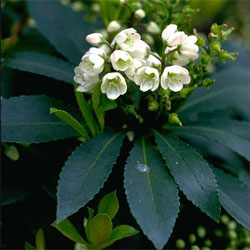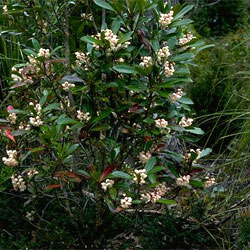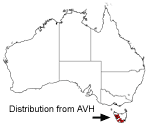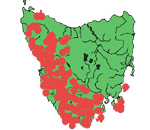Anopterus glandulosus
 |
 |
Native Laurel
Anopterus glandulosus, commonly known as the Native Laurel is an endemic of Tasmania and is limited to the rainforest and wet eucalypt forest of Tasmania below 1200 m. As the distribution map shows they are found mostly in the south and west of the state.

 Anopterus is a genus endemic to Australia with one species in NSW and Queensland and
one in Tasmania and is member of the family Escalloniaceace. The Escalloniaceace
consist of 17 genera and 70 species and are mainly found in the southern hemisphere.
Anopterus is a genus endemic to Australia with one species in NSW and Queensland and
one in Tasmania and is member of the family Escalloniaceace. The Escalloniaceace
consist of 17 genera and 70 species and are mainly found in the southern hemisphere.
This handsome evergreen species is usually a shrub 2- 4m. in height but sometimes forms a tree up to 10 m in habit. In habit and foliage the Native Laurel resembles another endemic species, the Native plume, Cenarrhenenes nitida, a member of the family Proteaceae with a more restricted distribution in rainforests. At all seasons Anopterus glandulosus is conspicuous because of its leaves, which are large, 7-17 cm. long and 2 – 4 cm. broad, and clustered chiefly at the ends of each of the branches; they are dark green, thick and glossy, and the margins have distant blunt teeth and glands. Large leaved plants are uncommon in Tasmanian forests and they make a spectacular contrast with the surrounding vegetation.
The showy white flowers are borne on slender pedicels arranged in terminal racemes, which are about as long as the leaves. The flowers are white or flushed with pink and are about 2cm across and are present in spring and often again in autumn. The fruit is a capsule, opening in two valves, which diverge above and become recurved, exposing winged seeds.
The species is very attractive and have considerable horticultural potential, it may be slow growing but are generally easy to grow in a partially protected situation. This may mean growing against a wall or a fence.
In cultivation it makes a very attractive shrub for the garden and is also well suited to large containers. Prefers semi-shade or cool conditions with ample water during summer. It favours free draining soils rich in organic matter and respond to the application of fertilizers or manures and mulches on the soil surface. It can be pruned annually to control shape.
Propagate from seed, which is fine and must be only lightly covered or from cuttings, which may be slow to strike.
Anopterus glandulosusis a hardy adaptable plant that attracts both nectar and insect eating birds; such as honeyeaters. The species is frost and snow tolerant and can handle temporary inundation. It also gets along with exotic species in the garden as it can withstand extra summer watering and also the morphology of the plant ie. leaf shape and flower appearance makes them blend happily with plants from other countries.
Text by Ian Warren, Botanical Intern 2003
Name meaning: Anopterus glandulosusAnopterus - comes from the greek word 'ano' meaning upwards and 'pteron' meaning wing. This is in reference to the upward facing wings found in Anopterus seeds. glandulosus - means glandular and is reference to the gland tipped teeth present on the leaves. |
References:
Cameron, M ed. 1981. Guide to flowers and plants of Tasmania, Reed, Sydney.
Curtis, W. M. & Stone, M. 1967. The Endemic Flora of Tasmania. The Ariel Press, London.
Elliot, W.R. & Jones, D.L. 1993. Encyclopaedia of Australian Plants Suitable for Cultivation. Lothian. Melbourne
O’Neil, V. 1990. Grow What Where. Penguin Books, Australia.
Kirkpatrick, J.B. & Backhouse, S. 1989. Native trees of Tasmania. Pandani Press, Hobart
![An Australian Government Initiative [logo]](/images/austgovt_brown_90px.gif)

